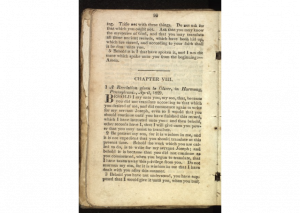Historical Context and Background of D&C 9

Video Overview
Brief Synopsis by Steven C. Harper
Oliver couldn’t translate. Why not, after the Lord had said he could? He wanted to know, and the Lord answered him in section 9.1 Oliver did not understand what it took to translate by the gift and power of God, and the only way he was going to gain understanding was to try it. He made a start but could not continue.
His efforts were undermined by his assumption that all he had to do was ask and the Lord would do the rest. Not so, the Lord explained. Oliver learned a lesson about revelation that is best understood through experience. Revelation is an active, not passive, process, requiring a combination of spiritual sensitivity and intellectual exertion. Before Oliver arrived on the scene, Joseph had also struggled to learn the process of revelation. Joseph worked hard to translate, to tap the gift and power of God. As a result of Oliver’s failure to translate and the Lord’s explanation, Oliver gained respect for Joseph’s gift that he would never lose and knowledge about the process of revelation that he would never forget.2
The process of revelation is usually learned after wrestling with it for a while, gaining experience with how it feels in both the heart and the mind and then applying it, as the Lord told Oliver to do in Section 8. This revealed recipe for receiving revelation is all contrary to the common refrain “just pray about it.” Revelation seldom comes so cheaply. The Lord promised Oliver other opportunities to translate later, but for now he was to finish what he had started: scribing the Book of Mormon. Oliver was faithful to that charge, as the manuscripts in his handwriting attest.3 Years later he testified, “That book is true. Sidney Rigdon did not write it. Mr Spaulding did not write it. I wrote it myself as it fell from the lips of the prophet.”4
1. “Revelation Book 1,” p. 14, The Joseph Smith Papers, accessed July 22, 2020.
2. Oliver Cowdery, Norton, OH, to William W. Phelps, September 7, 1834, LDS Messenger and Advocate, October 1834, 1:14.
3. Printer’s Manuscript of the Book of Mormon, circa August 1829-circa January 1830. Book of Mormon Original Manuscript (1829).
4. See Reuben Miller’s journal, 1848-1849, Church History Library, MS 1392.
Additional Context by Casey Paul Griffiths
From Doctrine and Covenants Minute
In Joseph Smith’s official history, Doctrine and Covenants 9 appears directly after section 8 without any explanation or introduction (History, 1838–1856, vol. A-1, 17). It is clear from the text of the revelation that Oliver attempted to translate but was ultimately unsuccessful. The Lord takes time to tenderly explain to Oliver why he was unable to translate.
See Historical Introduction, “Revelation, April 1829–D [D&C 9],” p. 20, The Joseph Smith Papers, accessed September 25, 2020, https://www.josephsmithpapers.org/paper-summary/revelation-april-1829-d-dc-9/1
